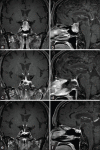The expanding role of the endonasal endoscopic approach in pituitary and skull base surgery: A 2014 perspective
- PMID: 26015870
- PMCID: PMC4443401
- DOI: 10.4103/2152-7806.157442
The expanding role of the endonasal endoscopic approach in pituitary and skull base surgery: A 2014 perspective
Abstract
Background: The past two decades have been the setting for remarkable advancement in endonasal endoscopic neurosurgery. Refinements in camera definition, surgical instrumentation, navigation, and surgical technique, including the dual surgeon team, have facilitated purely endonasal endoscopic approaches to the majority of the midline skull base that were previously difficult to access through the transsphenoidal microscopic approach.
Methods: This review article looks at many of the articles from 2011 to 2014 citing endonasal endoscopic surgery with regard to approaches and reconstructive techniques, pathologies treated and outcomes, and new technologies under consideration.
Results: Refinements in approach and closure techniques have reduced the risk of cerebrospinal fluid leak and infection. This has allowed surgeons to more aggressively treat a variety of pathologies. Four main pathologies with outcomes after treatment were identified for discussion: pituitary adenomas, craniopharyngiomas, anterior skull base meningiomas, and chordomas. Within all four of these tumor types, articles have demonstrated the efficacy, and in certain cases, the advantages over more traditional microscope-based techniques, of the endonasal endoscopic technique.
Conclusions: The endonasal endoscopic approach is a necessary tool in the modern skull base surgeon's armamentarium. Its efficacy for treatment of a wide variety of skull base pathologies has been repeatedly demonstrated. In the experienced surgeon's hands, this technique may offer the advantage of greater tumor removal with reduced overall complications over traditional craniotomies for select tumor pathologies centered near the midline skull base.
Keywords: Craniopharyngioma; chordoma; endoscopic endonasal surgery; endoscopic pituitary surgery; endoscopic skull base surgery; tuberculum sella meningioma.
Figures




Similar articles
-
[Endoscopic endonasal surgery for extrasellar tumors: case presentation and its future perspective].No Shinkei Geka. 2009 Mar;37(3):229-46. No Shinkei Geka. 2009. PMID: 19306643 Japanese.
-
Extended endoscopic endonasal approach to the midline skull base: the evolving role of transsphenoidal surgery.Adv Tech Stand Neurosurg. 2008;33:151-99. doi: 10.1007/978-3-211-72283-1_4. Adv Tech Stand Neurosurg. 2008. PMID: 18383814 Review.
-
Endoscopic endonasal resection of anterior cranial base meningiomas.Neurosurgery. 2008 Jul;63(1):36-52; discussion 52-4. doi: 10.1227/01.NEU.0000335069.30319.1E. Neurosurgery. 2008. PMID: 18728567
-
Risk factors associated with postoperative cerebrospinal fluid leak after endoscopic endonasal skull base surgery: Two-center retrospective cohort study.Surg Neurol Int. 2024 Aug 2;15:272. doi: 10.25259/SNI_331_2024. eCollection 2024. Surg Neurol Int. 2024. PMID: 39246766 Free PMC article.
-
[Extended endoscopic endonasal approach to skull base].Neurocirugia (Astur). 2012 Nov;23(6):219-25. doi: 10.1016/j.neucir.2012.05.003. Epub 2012 Aug 1. Neurocirugia (Astur). 2012. PMID: 22858054 Review. Spanish.
Cited by
-
Endoscopic transnasal skull base surgery: pushing the boundaries.J Neurooncol. 2016 Nov;130(2):319-330. doi: 10.1007/s11060-016-2274-y. Epub 2016 Oct 20. J Neurooncol. 2016. PMID: 27766473 Review.
-
Outcomes following endoscopic endonasal resection of sellar and supresellar lesions in pediatric patients.Childs Nerv Syst. 2019 Nov;35(11):2099-2105. doi: 10.1007/s00381-019-04258-1. Epub 2019 Jun 18. Childs Nerv Syst. 2019. PMID: 31214816
-
Endoscopic Endonasal Transclival Approach versus Dual Transorbital Port Technique for Clip Application to the Posterior Circulation: A Cadaveric Anatomical and Cerebral Circulation Simulation Study.J Neurol Surg B Skull Base. 2017 Jun;78(3):235-244. doi: 10.1055/s-0036-1597278. Epub 2016 Dec 22. J Neurol Surg B Skull Base. 2017. PMID: 28593110 Free PMC article.
-
Intraoperative Augmented Reality Visualization in Endoscopic Transsphenoidal Tumor Resection Using the Endoscopic Surgical Navigation Advanced Platform (EndoSNAP): A Technical Note and Retrospective Cohort Study.Cureus. 2025 Feb 26;17(2):e79714. doi: 10.7759/cureus.79714. eCollection 2025 Feb. Cureus. 2025. PMID: 40161054 Free PMC article.
-
Anatomical Step-by-Step Dissection of Complex Skull Base Approaches for Trainees: Surgical Anatomy of the Endoscopic Endonasal Approach to the Sellar and Parasellar Regions.J Neurol Surg B Skull Base. 2022 Aug 25;84(4):361-374. doi: 10.1055/a-1869-7532. eCollection 2023 Aug. J Neurol Surg B Skull Base. 2022. PMID: 37405244 Free PMC article.
References
-
- Al-Mefty O, Borba LA. Skull base chordomas: A management challenge. J Neurosurg. 1997;86:182–9. - PubMed
-
- Alahmadi H, Cusimano MD, Woo K, Mohammed AA, Goguen J, Smyth HS, et al. Impact of technique on cushing disease outcome using strict remission criteria. Can J Neurol Sci. 2013;40:334–41. - PubMed
-
- Apuzzo ML, Heifetz MD, Weiss MH, Kurze T. Neurosurgical endoscopy using the side-viewing telescope. J Neurosurg. 1977;46:398–400. - PubMed
-
- Barkhoudarian G, Del Carmen Becerra Romero A, Laws ER. Evaluation of the 3-dimensional endoscope in transsphenoidal surgery. Neurosurgery. 2013;73(1 Suppl Operative):ons74–8. - PubMed
Publication types
LinkOut - more resources
Full Text Sources
Other Literature Sources
Miscellaneous
